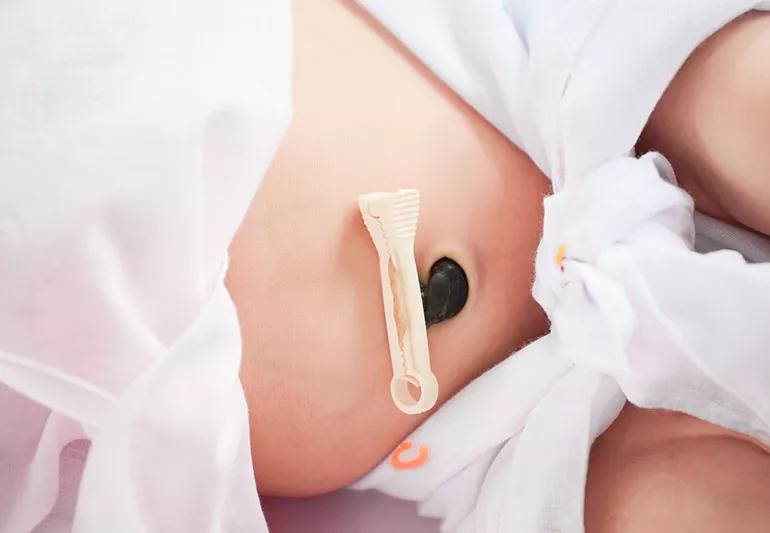An expert explains delayed cord clamping, including risks and benefits

A positive pregnancy test triggers a tsunami of decisions you need to make. Whether to delay cord clamping after the birth is one of them.
Advertisement
Cleveland Clinic is a non-profit academic medical center. Advertising on our site helps support our mission. We do not endorse non-Cleveland Clinic products or services. Policy
“The American College of Obstetrics and Gynecology (ACOG) and American Academy of Pediatrics (AAP) now recommend a delay in umbilical cord clamping in full-term infants (babies born after 37 weeks),” notes Ob/Gyn Jonathan Emery, MD. In this Q&A, he explains the pros and cons of delayed umbilical cord clamping.
A. Delayed cord clamping happens after the delivery of your baby, but before delivery of the placenta — when the baby is still attached to the umbilical cord. For many years, we’d clamp and cut the umbilical cord right after the baby came out. Then, we’d hand the baby to mom. All of this happened within 10 to 30 seconds.
With delayed cord clamping, we don’t cut the umbilical cord right away. We wait 30 to 60 seconds, sometimes up to five minutes, to clamp and cut the umbilical cord.
A. Before birth, when your baby is still in utero, your baby produces and uses fetal hemoglobin. Hemoglobin is an iron-containing protein in red blood cells. Fetal hemoglobin sucks up oxygen from the placenta and delivers it to the baby. After birth, babies stop producing fetal hemoglobin and instead use regular hemoglobin. Suddenly, babies need to make new red blood cells.
Studies have shown that waiting to clamp the umbilical cord for 30 to 60 seconds allows beneficial blood cells to get through the cord to the baby. That extra boost of iron helps babies transition to this new hemoglobin in the first weeks of life. Red blood cells can go from the placenta through the umbilical cord to the baby even up to five minutes after birth.
Advertisement
A. We recommend 30 to 60 seconds. When I mention lengths of time up to five minutes, I’m referring to cultures in and outside the United States who feel that the cord should stop pulsating before you cut it. But studies haven’t shown delaying longer than 30 to 60 seconds offers more benefits.
A. People cite four potential delayed cord clamping risks — some legitimate, some not so much:
Studies have shown that delayed umbilical cord clamping does not increase the risk of postpartum hemorrhage. Postpartum hemorrhage is a condition where you bleed excessively after giving birth. Waiting those 30 or 60 seconds won’t cause you to experience increased blood loss.
When fetal hemoglobin’s red blood cells break down, they form bilirubin. Bilirubin can be harmful for the developing brain.
The extra blood provided by delayed cord clamping can increase jaundice levels in babies because some develop problems with bilirubin. So delayed cord clamping may slightly increase the number of babies that need phototherapy treatment (also known as “bili lights”). With phototherapy, we put babies under an ultraviolet lamp to help break down bilirubin more quickly.
Polycythemia is when the baby has elevated red blood cell counts. It can cause the blood to thicken too much, leading to breathing and circulation problems and elevated bilirubin levels. There is a slight possibility that delayed cord clamping can cause the baby’s blood count to get too high, but we can manage it with phototherapy.
In utero, babies have fluid in their lungs. When a full-term baby is born and first breathes air, some of that fluid gets pushed out. Babies then cough out or slowly absorb any leftover fluid.
Some reports suggest that increased blood from delayed clamping can mean less room in the baby’s body to absorb the remaining fluid, leading to respiratory distress. But it’s a stretch to say that breathing trouble is a delayed cord clamping risk. There’s no link between delayed umbilical cord clamping and these potential breathing issues.
The risk for respiratory distress does come into play with preterm babies because there may be concerns about their respiratory development. But delayed cord clamping doesn’t affect this.
A. You can safely delay cord clamping by 30 to 60 seconds in both vaginal and cesarean deliveries. The baby should be:
You should NOT do delayed cord clamping if the baby:
If babies are preterm or not vigorous, we may have to clamp the cord immediately after birth so they can go to the NICU team for evaluation.
Advertisement
A. Delayed cord clamping can benefit preterm infants, but only if they’re stable enough to wait. Other things must happen, like getting the baby to the warmer. For a preterm infant that’s not getting enough oxygen, adding 30 to 60 seconds on top of any other delays may be too long.
You should also avoid delayed cord clamping if the preterm infant:
A. You can do both. Studies show you can still get enough cord stem cells to bank after delayed cord clamping. These stem cells could benefit your baby in the future, while delayed cord clamping benefits your baby in the present.
But you might have to pick one over the other if you want to wait past 60 seconds to do cord clamping.
A. Umbilical cord milking is when you push the blood through the cord instead of letting it passively go to the baby. This practice is more common for preterm infants.
Research does not show that umbilical cord milking is detrimental to full-term babies, but it’s unclear how vigorously you should milk the cord in preterm babies. Umbilical cord milking and delayed cord clamping have similar benefits in full-term infants.
Advertisement
A. Discuss your wishes with the person who will help deliver your baby. If you’re making a birth plan, write it down there. By choosing to delay cord clamping when your baby is healthy and full-term, you help ensure the best possible start for your little one.
Advertisement
Learn more about our editorial process.
Advertisement

Placenta consumption hasn’t been shown to have any health benefits, but it can cause infections

Sitting, squatting and side-lying may provide a more comfortable labor and delivery

Use relaxation techniques and breathwork to help manage the discomforts of a medication-free birth

Rinses, sitz baths, ice and medication can help the healing

Babies aren’t great about scheduling, so be sure to pack a month or two before your due date

You can plan for almost anything, but be flexible about the outcome

There are risks to having a C-section and benefits to vaginal birth

What to expect after having surgery

Start having sex about 72 hours before ovulation, then at least every other day during your fertile window

Attachment theory suggests that your earliest relationships shape connections throughout your life

It isn’t a recognized mental health disorder, but research shows that problematic social media use can negatively affect your mental health, self-esteem and sleep